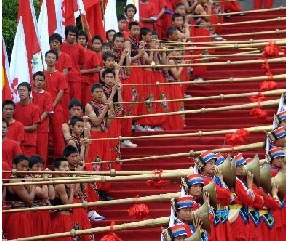Trombones of various nationalities
Trombone is also known as Changming, Tongjiao, Zhaojun, Horse Blowing, Horn and so on. It is Yao, Zhuang, Miao, Yi, Hani, Buyi, Tujia, Uyghur, Han and other nationalities lip-vibrating and chirping musical instruments. Yao language called Dangling. It is called Dabala in Yi language. The Bouyei language is called Manglie. Uyghur is called Kanai. The Han people call it the tuba, long tip, trumpet, aces and so on. Trombones of different ethnic groups and regions have different specifications and lengths.

Yao and Zhuang
The Dangling of the Yao people and the trombone of the Zhuang and Miao people are popular in western Guangxi and southeastern Guizhou. The overall length of the tube body is 155 cm. The upper section is 30 cm long, the top mouth is 5 cm in diameter and 0.8 cm deep, and the lower copper round is 6 cm in diameter. The middle section is 61 cm long, the trumpet section is 64 cm long, and the bell mouth diameter is 22 cm. When playing, the upper and middle sections are pulled out, the left hand is straight to support the tube body, the right hand holds the upper section, the tube body is slightly inclined to the left, and the mouth sticks to the pot-shaped horn to blow air, which is mostly the fundamental and the first and second. The second overtone, the sound is deep and deep, and the volume is loud, which can be heard for several miles. Usually not played alone. In Guangxi and Guizhou, it is the bass instrument of the eight-tone (that is, the Eight Immortals) bands of various ethnic groups. The music played are all octaves.
Yi people
The Daba of the Yi nationality is popular in Chuxiong, Dayao, Shidian in Yunnan and Xichang and Huili in Sichuan. In the Liangshan Yi Autonomous Prefecture Museum of Sichuan, there is a trombone of the Tusi family of Adu, with a total length of 171 cm, the upper section is 52.3 cm, the middle section is 60.5 cm, and the lower section is 59 cm. The mouthpiece has a diameter of 4.8 cm and an aperture of 3 cm. The trombone is a must-have instrument for Yi festivals, weddings, funerals, and other occasions. In traditional festivals, dozens of trombones are played at the same time. The sound is earth-shattering and the scene is extraordinarily spectacular.
Uighur
The Uyghur Kanai is popular in the Xinjiang Uygur Autonomous Region. Made of copper, three sections, 150 cm to 180 cm in length. It can play two tones, a barrel tone and a fifth overtone. In the past, it was often used in the welcome ceremony of the king and Burke; now it is mostly used in the mass singing and dancing activities of festive festivals, and it is often used as the bass instrument of the Nagra and Surna folk advocacy bands. During the performance, the barrel tone and the fifth harmonic are played from time to time, making it a continuous tone with a fixed pitch in the music. Because of its large volume, the performance effect is particularly strong, which can strengthen the prestige of the band and set off the festive atmosphere. Canai is often used in one pair or two or three pairs, and is rarely used alone. The musicians often stand symmetrically on both sides of the trumpet band, turning the direction of Kanai neatly, spreading the sound in all directions.
Han nationality
Horns in the Han area, generally 130 cm to 150 cm in length, are widely used in folk wind and percussion music in Jiangsu, Zhejiang, Fujian, Henan and other places, such as eastern Zhejiang gongs and drums, Shifan gongs and drums, etc. Trombones are also used in many opera music accompaniments, such as in traditional Peking Opera repertoires, in the ancient operas of northern Henan, southern Hebei, western Shandong, and northern Anhui Daping Diao (called long clips in troupes) and Daxian operas, In the accompaniment of Luo opera music, trombones are always used, and some even use two. Every scene such as the appearance of military generals, the promotion of marshals, the confrontation between the two armies, and the fighting, etc., must be played to show that the struggle is fierce and mighty. In some areas of Henan, several trumpets are also used in unison during folk festive activities.
 渝公网安备 50010702504639号
渝公网安备 50010702504639号